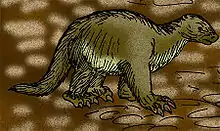Valgipes
Valgipes is an extinct genus of scelidotheriid ground sloth, endemic to intertropical Brazil during the Late Pleistocene. Thought to have been a forest-dwelling browser,[1] Valgipes is a monotypic genus with a complex and long taxonomic history, and is a close relative of Catonyx and Proscelidodon.[2]
| Valgipes | |
|---|---|
| Scientific classification | |
| Kingdom: | |
| Phylum: | |
| Class: | |
| Superorder: | |
| Order: | |
| Suborder: | |
| Family: | |
| Genus: | †Valgipes Gervais 1874 |
| Species: | †V. bucklandi Lund 1846 |
| Synonyms | |
| |
Taxonomy
The taxonomic history of Scelidotheriidae in Brazil is convoluted, and only one species of Valgipes, V. bucklandi, is recognised today, named in honour of William Buckland. Based on the remains of 23 individuals discovered in Lagoa Santa, Minas Gerais, in 1846 Peter Wilhelm Lund described two Brazilian scelidotheriids, Scelidotherium owenii and Scelidotherium bucklandi, while Winge (1915) named them as Scelidotherium magnum and Catonyx giganteus. In 1874, Paul Gervais erected the genus Valgipes for a different species, V. deformis, which he based on a calcaneum bone which he classified as scelidotheriid. Based on comparison of the heel bone with that of Megalonyx, in 1954 Robert Hoffstetter considered that the calcaneum came from an unusual member of the family Megalonychidae, a convention followed by later palaeontologists (although the species was declared incertae sedis in 1979) until the material was studied in further detail, leading to V. deformis and S. bucklandi being combined as Valgipes bucklandi by Cartelle et al. (2009). The only other valid scelidotheriid known from Brazil is Catonyx cuvieri.[2][3] Valgipes is differentiated from Catonyx based on dentition and postcranial morphology.[2]
Description
It is similar in size and morphology to Catonyx, with longer and more gracile limb bones, and a wider skull.[2] A number of adult skulls have sagittal crests, while others do not, suggesting possible sexual dimorphism.[4] The claws are narrow and curve gently towards the palm, with the largest claw being on the third digit. Like some other members of the families Mylodontidae and Scelidotheriidae, it had bony osteoderms embedded in its skin.[2]
Paleoecology
During the Late Pleistocene, the habitat type of the regions inhabited by Valgipes is thought to have been mainly tropical dry forest. Isotopic analysis of a specimen from Rio Grande do Norte indicates it was a browsing animal which lived in relatively closed environments, including the Atlantic Forest, and had a varied diet of leaves, shoots, roots, and fruits.[1]
Distribution
Fossils of V. bucklandi have been found in:
- Pleistocene
References
- dos Santos Pereira, I. C.; et al. (2013). "Record of the giant sloth Valgipes bucklandi (Lund, 1839) (Tardigrada, Scelidotheriinae) in Rio Grande do Norte state, Brazil, with notes on taphonomy and paleoecology". Journal of South American Earth Sciences. 43: 42–45.
- Cartelle, Castor; et al. (2009). "Systematic revision of intertropical Scelidotheriinae (Xenarthra, Mylodontidae)". Journal of Vertebrate Paleontology. 29 (5): 555–566.
- Fariña, Richard A.; Vizcaíno, Sergio F.; De Iuliis, Gerry (2013). Megafauna: Giant Beasts of Pleistocene South America. Indiana University Press. pp. 205–206. ISBN 9780253007193.
- Miño-Boilini, Ángel R.; Zurita, Alfredo E. (2015). "Dimorphism in Quaternary Scelidotheriinae (Mammalia, Xenarthra, Phyllophaga)". Palaeontologia Electronica. 18 (1).
- de Sousa DV, Eltink E, Oliveira RA, Félix JF, Guimarães LM (December 2020). "Diagenetic processes in Quaternary fossil bones from tropical limestone caves". Scientific Reports. 10 (1): 21425. doi:10.1038/s41598-020-78482-0. PMC 7722736. PMID 33293631.
- Miño-Boilini, Ángel R.; et al. (2012). "Revisión sistemática y taxonómica del género Scelidotherium Owen, 1839 (Xenarthra, Phyllophaga, Mylodontidae)". Revista Brasileira de Paleontología. 17 (1): 43–58.
- Valgipes at Fossilworks.org

